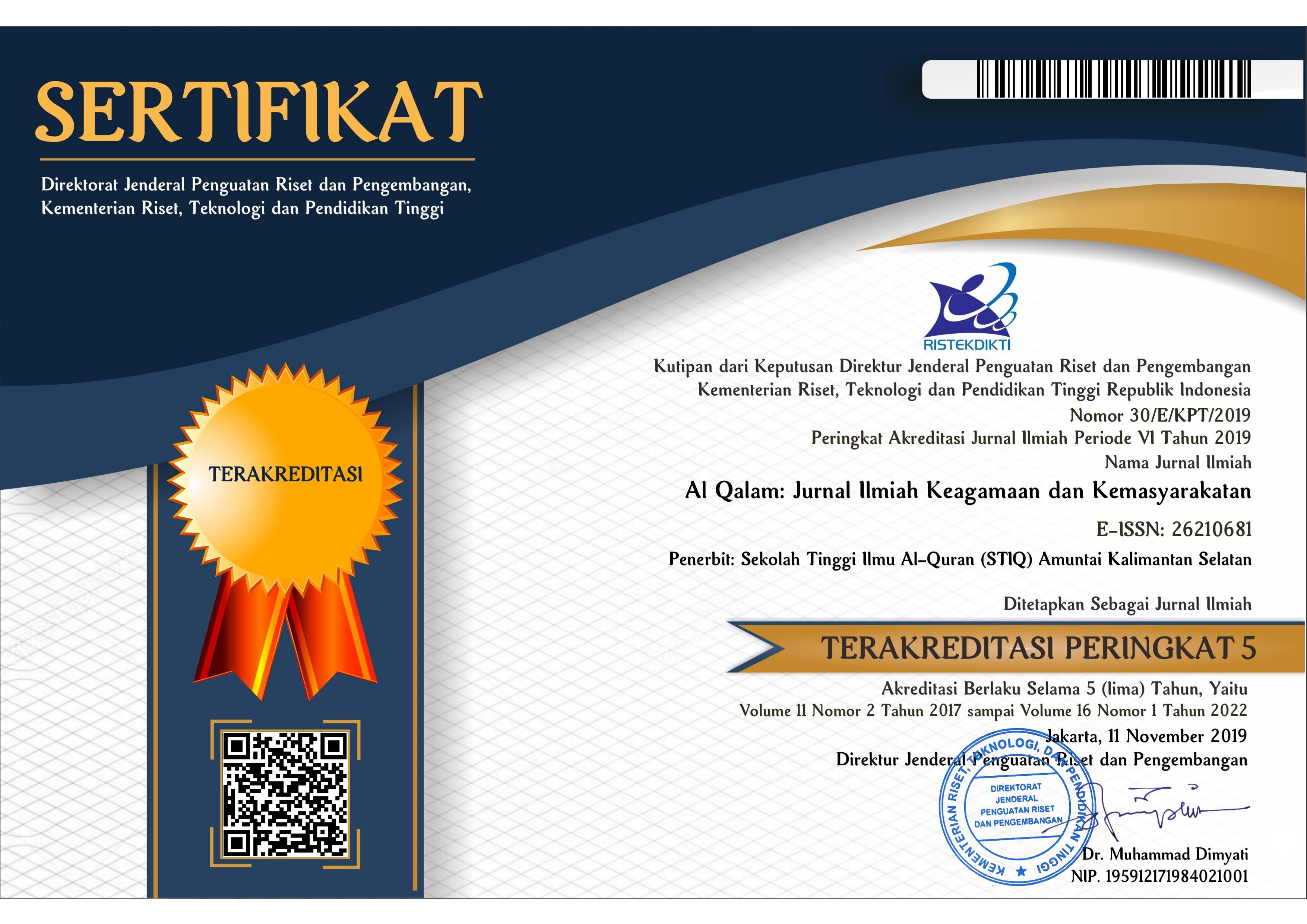Evaluation of the Application of Blended Learning in PAI Subjects at SMAN 1 Prambon, Nganjuk
Abstract
Keywords
Full Text:
PDFReferences
Ananda, Rusydi, Rafida, Tien. Pengantar Evaluasi Program Pendidikan. Medan: Perdana Publishing, 2017.
Bowyer, Jessica. “Evaluating Blended Learning: Bringing the Elements Together.” RESEARCH MATTERS, no. 23 (2017): 17.
Ceylan, Veysel Karani, and Ayse Elitok Kesici. “Effect of Blended Learning to Academic Achievement.” Journal of Human Science 14, no. 1 (2017): 310.
Dwi Muryadi, Agustanico. “Model Evaluasi Program Dalam Penelitian Evaluasi.” Jurnal Ilmiah PENJAS 3, no. 1 (January 2017): 5.
Ezgi, Darama, Karaduman Fethi, Kahraman Kadir, and Gundogdu Kerim. “Evaluation of 5th Grade English Curriculum According to Stufflebeam’s Context, Input, Process, Product (CIPP) Model.” International Journal of Psycho-Educational Sciences 7, no. 2 (September 2018): 76.
Gede Hendra Devayana, Dewa. “Evaluasi Pelaksanaan Blended Learning Di SMK TI Udayana Menggunakan Model CSE-UCLA.” Jurnal Pendidikan Vokasi 7, no. 1 (February 2017): 64–77.
Hubackova, Sarva, and Ilona Semradova. “Evaluation of Blended Learning.” Procedia: Social and Behavioral Sciences, 2016.
Husamah. Pembelajaran Bauran: Blended Learning. Surabaya: Prestasi Pustaka, 2014.
Indrawan, Irjus. Pengantar Manajemen Sarana Dan Prasarana Sekolah. Yogyakarta: Deepublish, 2015.
Jamali, Arif, and Lantip Diat Prasojo. “Pengaruh Kompetensi Manajerial Kepala Sekolah, Lingkungan, Motivasi Guru, Terhadap Prestasi Siswa SMA Muhammadiyah Kota Yogyakarta.” Jurnal Akuntabilitas Manajemen Pendidikan 1, no. 1 (2013).
Jumari, and Suwandi. Evaluasi Program Pendidikan Madrasah Ramah Anak: Tinjauan Teoritis Dan Praktis Berbasis CIPP Model. Jawa Barat: Adanu Abimata (Adab), 2020.
Mahmudi, Ihwan. “CIPP: Suatu Model Evaluasi Pendidikan.” At-Ta’dib 6, no. 1 (June 2011): 121.
Majid, Dhea Abdul. “Pembelajaran Pendidikan Agama Islam (PAI) di Sekolah Berbasis Blended Learning.” Al-Tarbawi Al-Haditsah: Jurnal Pendidikan Islam 4, no. 1 (July 31, 2019). https://doi.org/10.24235/tarbawi.v4i1.4209.
Mehmet, Basaran, Busra Dursun, Hatice Damla Gur Dortok, and Gokhan Yilmaz. “Evaluation of Preschool Education Program According to CIPP Model” 6, no. 2 (2021): 3.
Muhson, Nurul. “Penerapan Blended Learning Dalam Meningkatkan Hasil Belajar PAI Materi Sejarah Bani Umaiyah Kelas Viii Smpn 3 Pontianak.” Sosial Horizon: Jurnal Pendidikan Sosial 6, no. 1 (September 6, 2019): 12–25. https://doi.org/10.31571/sosial.v6i1.1230.
Nanindya Wardani, Deklara, Toenlioe Anselmus J.E, and Agus Wedi. “Daya Tarik Pembelajaran di Era 21 Dengan Blended Learning.” JKTP 1, no. 1 (April 2018): 15.
Nugroho, Risky Aviv. “Penerapan Metode Blended Learning Dalam Pembelajaran PAI pada Era New Normal.” As-Salam: Jurnal Studi Hukum Islam & Pendidikan 10, no. 1 (June 22, 2021): 17–30. https://doi.org/10.51226/assalam.v10i1.200.
Putro Widoyoko, Eko. Evaluasi Program Pembelajaran: Panduan Praktis Bagi Pendidik Dan Calon Pendidik. Yogyakarta: Pustaka Pelajar, 2010.
Ridha Albaar, Muhammad. Desain Pembelajaran Untuk Menjadi Pendidik Yang Profesional. Ponorogo: Uwais Inspirasi Indonesia, 2020.
Stufflebeam, Daniel L., and Chris L. S. Coryn. Evaluation Theory, Models, and Applications. Second edition. Research Methods for the Social Sciences 50. San Francisco: Jossey-Bass & Pfeiffer Imprints, Wiley, 2014.
Sugiyono. Metode Penelitian Pendidikan Pendekatan Kuantitatif, Kualitatif, Dan R & D. Bandung: Alfabeta, 2014.
———. Metode Penelitian Pendidikan (Pendekatan Kuantitatif, Kualitatif, R & D). Bandung: Alfabeta, 2016.
Triyadi Bempah, Ramdhan. “Menteri Nadiem Makarim Persilakan Dana BOS Dipakai Beli Kuota Internet Untuk Belajar Daring.” Kompas, July 31, 2020.
Tsani, Iskandar, Rofik Efendi, and Sufirmansyah Sufirmansyah. “Evaluasi Kesiapan Lembaga Pendidikan Tinggi Islam Dalam Menghadapi Era Digital.” Ta’dibuna: Jurnal Pendidikan Islam 9, no. 1 (April 4, 2020): 019. https://doi.org/10.32832/tadibuna.v9i1.2604.
Widiara, I Ketut. “Blended Learning Sebagai Alternatif Pembelajaran Di Era Digital.” Purwadita 2, no. 2 (September 2018): 55.
Yusny, Rahmat, and Ghufran Ibnu Yasa. “Mengembangkan (Pembelajaran) Blended Learning Dengan Sistem Lingkungan Pembelajaran Virtual (VLE) di PTKIN.” Jurnal Ilmiah Islam Futura 19, no. 1 (October 12, 2019): 103. https://doi.org/10.22373/jiif.v19i1.3707.
DOI: http://dx.doi.org/10.35931/aq.v17i3.2107
Refbacks
- There are currently no refbacks.
Copyright (c) 2023 Al Qalam: Jurnal Ilmiah Keagamaan dan Kemasyarakatan
Al Qalam: Jurnal Ilmiah Keagamaan dan Kemasyarakatan
index by:
Publish by:
Sekolah Tinggi Ilmu Al-Qur'an Amuntai
Contact us:
Address: Jl. Rakha Pakapuran, Amuntai Utara
Kabupaten : Hulu Sungai Utara
Kode Pos : 71471
Provinsi : Kalimantan Selatan
Telephone : 085251613000
Email: hafizhihusinsungkar@gmail.com

This work is licensed under a Creative Commons Attribution 4.0 International License


